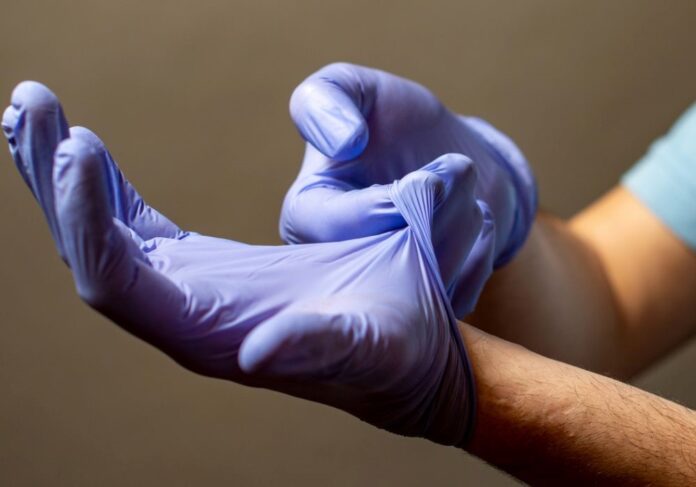Proper sanitation in medical offices and clinics plays a prominent role in maintaining a healthy, safe, and successful healthcare service. Many practices, such as the use of personal protective equipment (PPE) like gloves, can maximize workplace hygiene.
From rotating outside visitors to the various threats of a medical environment—diseases, chemicals, radioactive waste—PPE is important to maintain a clinic’s safety. Gloves protect medical staff from hazard exposure and prevent the spread of illness.
However, latex gloves—the most popular glove in the medical field—come with their own dangers. Here are three alternatives to latex gloves and the importance of providing your healthcare team with various PPE options.
The Dangers of Latex Allergies
Latex allergies are among the most common workplace hazards in dentistry and other healthcare services. It causes a range of reactions, from irritable rashes to anaphylaxis.
On top of health issues and life-threatening scenarios, latex allergies also affect performance and productivity.
High performance and productivity hindrances lead to possible life-and-death situations for medical professionals. Minimizing risks of latex allergic reactions in your healthcare clinic maximizes the safety and success of your business.
Powder-Free Vinyl
Vinyl gloves are synthetic alternatives to latex. They feature a petroleum-based film of polyethylene terephthalate (PET) and polyvinyl chloride (PVC), making the gloves affordable and easy to make.
Vinyl gloves are less durable than latex. They are more suitable for short-term and light-duty examinations that stay on the surface level.
Most vinyl gloves come powdered for easier application and removal and added comfort between the skin and non-slick vinyl material.
Cornstarch and other common glove powders, however, come with high risks of irritation. If you use vinyl gloves in the office for basic check-ups and light-duty tasks, opt for powder-free variations.
Heavy-Duty Neoprene
Many workers in industrial spaces use neoprene gloves when handling higher-risk tasks. They are heavy-duty with high resistance to punctures, chemicals, and abrasive surfaces. They protect you from a range of solvents and oils, making them great for surgical procedures.
Their water-resistant fabrication also makes these gloves suitable for dental work, where a lot of water and liquids are involved. They consist of a synthetic rubber material, eliminating the potential of a latex allergic reaction. With its various functions and high durability, neoprene comes at a higher price than latex alternatives.
Multipurpose Nitrile
Nitrile is the best latex alternative for medical purposes. Like neoprene, nitrile gloves feature high puncture, abrasion, and chemical resistance. They come at an affordable price and are easier to obtain.
They derive from a fortified synthetic rubber called butadiene, making them durable, hypoallergenic, and suitable for various medical tasks.
Whether you are handling hazardous waste—urination samples or discarded body parts—or chemicals, nitrile gloves protect you from burns, germs, and more. On top of protecting you from harm, they don’t skimp on hypoallergenic features.
Supplying your healthcare businesses and professionals with latex glove alternatives minimizes health and safety risks in your clinic.
It ensures your experts stay protected from exposures, work in ideal conditions, and get the job done with ease and minor mishaps. Enhance your healthcare business with the best equipment in your field, like durable, latex-free gloves.
Read Also
- How to Drive Growth Through Customer Centricity in HealthcareThe world of healthcare is changing in big ways. Consumers are now stepping up and taking charge of their health journeys. This change is happening now for important reasons. The U.S. health and wellness market is huge, projected to be over $6 trillion in 2025. This growth is fueled by rising out-of-pocket costs and more… Read more: How to Drive Growth Through Customer Centricity in Healthcare
- Maximizing Digital Reach for Podiatry Clinics in Local HealthcareMaximizing Digital Reach for Podiatry Clinics in Local Healthcare As the healthcare industry evolves, mobile marketing becomes indispensable for practitioners. Podiatry clinics, focusing on foot and ankle care, must adapt to digital strategies to engage patients effectively. Implementing tailored SEO practices is crucial for these clinics to thrive in an increasingly competitive market. Digital marketing… Read more: Maximizing Digital Reach for Podiatry Clinics in Local Healthcare
- Leveraging Virtual Medical Assistants to Maximize Operational Efficiency in HealthcareIn the increasingly complex and fast-paced world of healthcare, operational efficiency is critical. Doctors and healthcare administrators are faced with numerous challenges, from managing patient scheduling and medical billing to adhering to stringent regulatory compliance and insurance claims processing. These tasks, while essential, often divert time and resources away from the core mission of providing… Read more: Leveraging Virtual Medical Assistants to Maximize Operational Efficiency in Healthcare
- Optimizing CT Protocols: The Hidden Key to Efficiency and Cost Savings in RadiologyIntroduction: Why CT Protocol Optimization Matters Computed Tomography (CT) is a cornerstone of modern diagnostic imaging, providing critical information across nearly every medical specialty. However, maximizing the value of CT — both clinically and financially — requires more than just advanced hardware. The real secret lies in the optimization of CT protocols. When CT protocols… Read more: Optimizing CT Protocols: The Hidden Key to Efficiency and Cost Savings in Radiology
- Hospital Discharge Accuracy Improves With Daily Advisor InvolvementThe hospital discharge process has a big effect on patient recovery, hospital efficiency, and finances. It requires careful planning and clear communication between team members to make sure patients get the right care when they leave the hospital. Having physician advisors involved at this stage can improve the discharge process by spotting problems that need… Read more: Hospital Discharge Accuracy Improves With Daily Advisor Involvement






